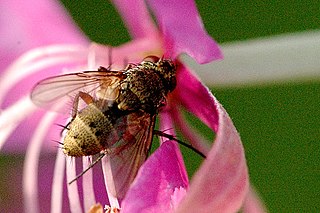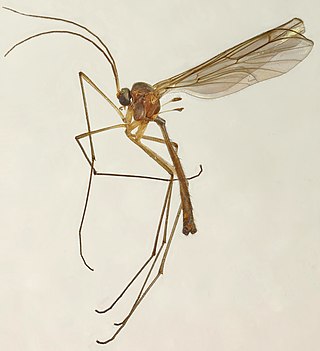
Mycetophilidae is a family of small flies, forming the bulk of those species known as fungus gnats. About 3000 described species are placed in 150 genera, but the true number of species is undoubtedly much higher. They are generally found in the damp habitats favoured by their host fungi and sometimes form dense swarms.

Allophorocera is a genus of flies in the family Tachinidae.

Ceranthia is a subgenus of flies in the family Tachinidae. Some consider this to be a subgenus of Siphona, most European workers seem content that this is a genus in its own right.

Nilea is a genus of flies in the family Tachinidae.
Phebellia is a genus of flies in the family Tachinidae.

Phyllomya is a genus of flies in the family Tachinidae.

Platymya is a genus of flies in the family Tachinidae.

Criorhina is a genus of hoverflies. Medium to large sized species, black or greenish black, with or without light ground markings mimicking bumblebees. The head is much flattened and broader than the thorax. The antennae are situated upon a prominent conical frontal process, The face is moderately produced below the eyes, downward or forward, in profile. The eyes are bare. The abdomen is elliptical or very short oval. Larvae found in rot holes or decaying hardwoods

Bolitophila is the sole living genus in the Bolitophilidae, a family of Diptera in the superfamily Sciaroidea, with around 40 Palaearctic and about 20 Nearctic species, and three species from the Oriental region (Taiwan). They are small (6–9 mm).

The Ditomyiidae are a small family of flies (Diptera).They are found worldwide, most species are found in the Australasian and Neotropical realms. There are only two genera in Europe Ditomyia Winnertz, 1846 and Symmerus Walker, 1848 Ditomyia is found in Central Europe Symmerus in Northern Europe Symmerus is endemic to the Palaearctic.

Pales is a genus of flies in the family Tachinidae.

Pachygastrinae is a subfamily of flies in the family Stratiomyidae.
Hoplodictya is a genus of marsh flies in the family Sciomyzidae. There are about five described species in Hoplodictya.

Lygistorrhininae, commonly called long-beaked fungus gnats is a subfamily of flies in the Diptera family Keroplatidae. The groups was long treated as a separate family, but molecular phylogenetic analysis has shown it to belong to Keroplatidae. There are about 7 genera and at least 30 described species in Lygistorrhininae.
Zabrachia polita is a species of soldier fly in the family Stratiomyidae.
Leptomorphus hyalinus is a species of fungus gnats, insects in the family Mycetophilidae.
Nervijuncta is a genus of fungus gnats in the family Ditomyiidae.

Allodiopsis is a genus of fungus gnats belonging to the family Mycetophilidae.
Rocetelion is a genus of flies belonging to the family Keroplatidae.












